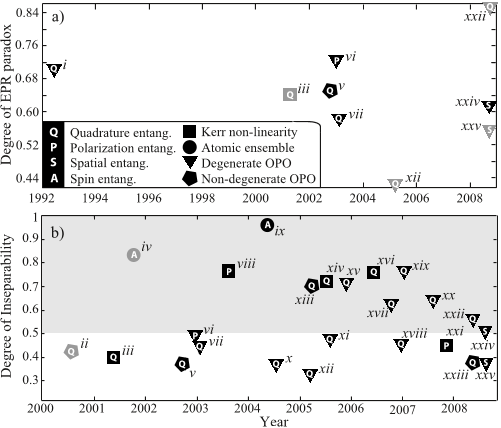




read more











In these steady-state continuous-wave experiments, however, the squeezing parameter r is time independent, and given by the inputoutput parametric gain G, such that G=e2r.
Due to the high peak powers of the frequency doubled pulses as well as the particular choice of a highly nonlinear optical material KNBO3 , the use of a cavity was circumvented despite the fact that a very thin 100 m crystal was employed.
Using fieldquadrature measurements and multiparticle states, it is likely that quantum theory and its alternatives can be tested for increasingly macroscopic systems Marshall et al., 2003 using the EPR paradox.
A degenerate waveguide technique, together with a beam splitter, was recently used to demonstrate pulsed entanglement using a traveling-wave OPA Zhang et al., 2007 .
One might expect that since spin-squeezed and entangled atomic ensembles contain a large number N of atoms, the decoherence rate of such systems would scale as N , where is the single-atom decay rate.
a critical feature of these collective spin states is that excitation due to interaction with light is distributed symmetrically amongst all of the atoms.
A well-accepted measure of teleportation efficacy is the overlap of the wave function of the output state with the original input state.
Since the set of predicted distributions are the conditionals P x xB , one for each value of xB, the logical choice is to label the element of reality by the outcomes xB, but bearing in mind the set of predetermined results is not the set xB , but is the set of associated conditional distributions P x xB .
For a Gaussian distribution of coherent states, with mean photon number n̄, the average fidelity using classical measure and regenerate strategies is limited to F n̄+1 / 2n̄+1
The quantum noise properties were characterized at a specific Fourier component within a narrow frequency band, typically in the range 100–300 kHz.
The first experimental realization of pulsed EPR entanglement, shown in Fig. 7, was based on the approach of mixing two squeezed beams on a 50/50 beam splitteras outlined above for continuous wave light.
The symmetry of the entangled beams allowed one to infer from this number the degree of EPR violation, which was found to be 2=0.64±0.08.
These techniques have significant potential for quantum information networks Duan et al., 2001 and are also capable of generating a collective entangled state of the form required to test the EPR paradox.
The other approach to experimental demonstration of collective spin entanglement in atomic ensembles is to rely on conditioning measurements to prepare the state Julsgaard et al., 2004; Chou et al., 2005 .
The optimum level of EPR paradox achieved to date was by Bowen, Schnabel, et al. 2003 using a pair of type The authoroptical parametric oscillators.
The first experimental demonstration of quantum state transfer from the polarization state of an optical field to the collective spin state of an atomic ensemble was performed by Hald et al.